Wi-Fi
John MacDougall, Annie Laurie, #26
Typically when I'm out voyaging, I don't have need for internet, nor even e-mail, and almost never even have a computer on board at all.... But, times do change....and with the possibility of living on-board (part-time to start with) being realistic in the near future, I thought that having internet access on-board might be useful … so, I thought a decent wi-fi set-up would be a good idea.
This is a simple long-distance Wi-Fi "how-to", for those who are computer-friendly, but a long way from being IT-types! It is NOT intended to be a definitive white paper on wi-fi on-board..... Also, while there are many discussions throughout the cruising / sailing websites about how to get wi-fi access on board, many are based on either:
a) that one writer's only attempt and lucky success (and sometimes using something bought from a mass merchandiser, rather then researched for optimal performance, nor sourced from a specialty distributor…)
…or…
b) a complex (and somewhat expensive) IT approach which, although very efficient, can be difficult for laypersons to duplicate.
This "how-to" bridges that gap, since I did quite a bit of research prior to embarking on this project, as well as considerable testing of the specific Wi-Fi adapter I chose (Alfa AWUS036H) for about a year..... and then bought the "new and improved model" with its 1 watt (1000mw) power output, for actual install on board.
I will attempt a brief primer on what's what, and some of my reasoning, before delving into my "how-to"…
BUT, again, please be aware that this is NOT intended to be a definitive paper about use of wi-fi on board, rather just an overview, along with my choices and "how-to".
So, if you can drill a few holes in a plastic electrical box, plug-in a few cables, and route a cable thru your boat…you can have a very hi-quality (and reliable) long distance Wi-Fi set-up on board…and all for about $100, or a little more for a rather nifty permanent install.
I will be using only a few technical words / specs, since this is intended mainly for the non-technical types out there.
This is about 802.11b/g Wi-Fi, which is 2.4Ghz (2400 Mhz) Wi-Fi and is ubiquitous. The newer so-called "wireless N" (802.11n) is a 5.8 Ghz system and is not widely used, so I'll not be covering that at all…(there are simple cheap wireless N solutions available as well…I've tried them, and have experience with them…but there really aren't any wireless N systems out there for cruising sailboats to use…so no need to worry about that at this time.)
The short primer…
There are 3 or 4 basic ways to use / utilize a Wi-Fi connection from on-board your typical cruising sailboat:
- Use the internal Wi-Fi set-up, built-in most all modern laptop computers…which has very limited range. This is only useful when actually IN a specifically designed Wi-Fi "hotspot" (such as marina), since the typical laptop's wi-fi system uses a rather inefficient (but invisible) built-in antenna and a fairly low-power wi-fi transmitter output of approx. 25mw (1/40 of a watt).
-
A "USB-based" plug-in external Wi-Fi "adapter"…these are actually entire Wi-Fi transceivers, which can provide an astounding increase in range, all-the-while being both simple ("plug-n-play") and cheap ($30 - $50)…as well as being very versatile and completely portable, useable on-board, in-town/in-port, and at home, or on the road, almost anywhere in the world.
These USB plug-in devices can be either:
- Simple USB "dongles" with limited power outputs and no provision for external antennas....or...
- Small external devices the size of a deck of playing cards.....most of which have removable external antennas, and many have power outputs 10 - 20 times that of a laptop's internal wi-fi transceiver.....
Also, some of these are specifically designed / marketed for weak wi-fi signal areas, so they have much improved RECEIVE signal sensitivity as well.
{ Some examples of these latter types are the Alfa AWUS036H with 500mw to 1 watt power output and excellent receive sensitivity ( http://www.data-alliance.net/-strse-73/Alfa-AWUS036H-500mW-USB/Detail.bok ) and the Engenius EUB 362-Ext (200mw)…these are approx. $35 - $45…and available in all developed and developing countries worldwide, and on-line everywhere…some of you may have read of a product called "5 mile wi-fi", which works NO better than (and typically not even as good as) the Alfa unit, but costs $400, more than 5 or 6 times the cost of an entire Alfa set-up with antenna/cables, etc…so, this one fact may end up saving someone some $$$.}
[ Please note, I have personal first-hand experience with only these first 2 types of wi-fi set-ups on board…But, have read and researched much on the remaining two wi-fi set-up types…and have used the 4th type (specifically Engenius 3220-Ext's) on land.
The 3rd type seemed too pricey vs. the results, and since are designed for a specific application, are not as versatile as other solutions… as well as uncertainly whether the companies would be around to support their product. The 4th type seemed like a good idea, but I was looking for something simple, cheap, and very "plug-n-play".
However I would consider either of these last two set-ups, if my Alfa-based set-up failed to live up to its designed results.]
-
An Ethernet-based (and Power-Over-Ethernet, or POE) external Wi-Fi transceiver, designed specifically for the marine / RV market…and in addition to being a bit of a "niche"-market product from small companies, with questionable hopes of their long-term existence (and possibility of ending up with an "orphaned" device), some are also over priced. Although some of these DO work very well, and do have high power output specs (500mw to 1 watt), and decent receive sensitivity, they mostly do no better than (and some not as good as) the best of the cheap external USB-based Wi-Fi units.
{ The Ubiquiti Bullet HP2 is nice piece of reasonably-priced (~ $100 plus antennas/cables) gear, and although it's a POE device, it is a fairly simple plug-n-play unit…and, although not as versatile as a USB-based wi-fi unit, I would consider it my clear second choice!!! }
-
Sophisticated external Wi-Fi set-up, using a specific (or purpose-built) product programmed as a "client bridge". With high power outputs (400mw to 1 watt) and good receive sensitivity, coupled with external antennas, they DO work well…but can be a bit complex, and require someone with decent computer skills/knowledge to set-up…as well as most of them needing 48 volts DC for power, requiring a 110 volt AC supply or a 12vdc to 48vdc converter.
Also, some users of these external client bridges on board, have reported (Re: SSCA Disc Boards) them causing interference (RFI) to other radios (both HF and VHF), which may be moot for many since the likelihood of using Wi-Fi at the same time as other radios is low, but this is something to consider (as well as what interference it may cause to other boats anchored nearby).
{ Some examples are Engenius EOC-3220 Ext and EOC-8610S...these are approx. $125 to $250, plus cables/antennas and mounting arrangements…and available on-line, but not widely distributed.}
So, now that the primer is over....whew!
How about a quick how-to????
-
First off, some may be asking "why so much concern for decent wi-fi, since I've no troubles now???" The answer lies when you venture away from US marinas, and/or the US mainland…in many areas of the developing world where you're likely to be sailing, there are few places where you'll find "aircards" or "3G" to be workable solutions, and many cruisers have been relegated to internet cafes, etc. for internet access, if they're not equipped with a decent wi-fi system. Also, in areas that do have developed IP-based wireless systems, you may wish to save some $$$…maybe not, but hey I do have some of my Dad's Scottish blood in me. :)
-
Secondly, you can have a very nice, hi-quality on-board Wi-Fi system for a lot less money than some may think…anywhere from $40 to $250 (max)…which allows you to have on-board spares, as well as keep some extra cash in your wallet.
-
As for what I put together and why:
-
Almost a year ago, after some extensive reading of sailing/cruising websites (SSCA, Cruisers Forum, Panbo, etc.) as well as my own research of factory-published specs, I choose an Alfa AWUS036H USB-based external Wi-Fi unit. Of all the inexpensive plug-n-play USB-based Wi-Fi units, it had the best receive sensitivity specs and highest transmitter power output (now 1 watt / 1000mw…or double the original 500mw). {If I was spending a bit more $$$, and wishing a ethernet-based unit, today I might choose the Bullet HP2…but that's another discussion altogether.}
I initially used the Alfa unit with its supplied 3" long 2db gain antenna…both indoors (on shore) and on-board. This allowed me to have high-speed broadband access to the internet for FREE, from a few different sites.
Indoors, with the unit near many big glass sliding doors, at an elevation of about 32' above sea level (house on a hill) and a wide open view across water and other homes / restaurants / etc. Typically I had 4 - 5 Wi-Fi signals (signal strengths of 3-4 bars) with usually 2 of these "unsecured"…this compared to only ONE Wi-Fi signal ("secured") received from my laptop's internal Wi-Fi unit, and that one was "secured".
When on-board, I initially used my laptop in the cockpit, or at the Nav Station, placing the Alfa unit either on the deck or on top of the dodger…meaning it was now only 6' to 9' above sea level and with the hill blocking 180 degrees of the area. But this gave me many more Wi-Fi sites…with typically 8 - 9 Wi-Fi sites (signal strengths of 3 - 5 bars)…and usually more than half of them "unsecured". A truly useable set-up…which only cost me $43.
-
Then as I spent some time using this unit at client's offices and other locales, with excellent results, as I returned to Stuart and found the same few wi-fi signals when indoors, I thought "I need a bigger antenna" so I can get more signals....while that might sound strange to some, my fellow ham radio operators will understand!!!
I purchased a cheap (~ $9) 8.5 db antenna (14" long) that simply screwed in-place of the smaller original antenna. This allowed a little bit better signal strength indoors, but not much. Although now, when on board the boat, I got even more signals…now always more than 12 and many times more than 15 - 16 …with the unit sitting on top of the dodger, about 9' - 10' off the water. This was very good news. But, this antenna was just a bit too big to be regularly used with this unit (unwieldy is a good description), and since neither were designed for use outdoors and hence not waterproof, I then realized that spending just another few dollars will get me a decent weatherproof and permanent installation on board… So, that's what I did.
-
I also noticed that Alfa had improved their AWUS036H with more power output…so I thought, hey why not just use my original unit as a spare and buy the new one. So, here's the run down of the parts I used and their approx. prices:
- 1 - Alfa AWUS036H Wi-Fi unit = $43
- 1 - 16" tall 8.5 db gain omnidirectional outdoor Wi-Fi antenna (Engenius 2408 or equiv.) = $18 (including SS mounting bracket and hardware)
- 1 - 10" long coax cable (LMR-200) to connect Alfa to antenna = $6
- 3 - 16' long Active USB Extension cables (some might not need 3 of these) = $27
- 1 - 6" x 6" x 4" grey pvc waterproof electrical box, and waterproof wire feed-thru = $12
That brings my total so far to about $106…but some sailors are simply hanging their Wi-Fi units from a flag halyard or are using a clamp-on mounting bracket on a rail, etc.…and some may wish not to mount the unit way back on the stern rail (as I did), so the 2 extra Active USB extension cable may not be needed by all, saving some $20. {Also of note is my use of these "active USB cables"…if you're extending a USB-based unit more than 15' you should always use these "active" cables (meaning that they have a signal amplifier built-in to them).}
-
Since my desire was for a out-of-the-way, permanent installation that would survive harsh conditions, I thought I should spend some extra $$ on making it secure…so, I did. I added:
- 1 - 4' Shakespeare Galaxy antenna extension = $80
- 1 - 1' SS antenna extension = $35
- 1- Heavy Duty SS antenna rail mount = $40
That brings my total expenditure to about $255…
Most of which is for the mounting and weatherproofing.
The reason I've detailed my progression of this project over the past year, as well as what results I've gotten along the way, is so that others can actually see what you get for your $$ and efforts.
I did all the work myself, and sourced all the electronic components from on-line Wi-Fi vendors (specifically Data-Alliance, who are REALLY nice guys), the "marine stuff" (antenna extensions and rail mounts, etc.) from West Marine, and the waterproof box from Home Depot. The assembly and mounting of the final set-up took only an hour or so…but running the wiring took me another hour or so. Heck it took me twice as long to write all of this. :)
I do hope this helps some of you looking for a cheap and easy Wi-Fi solution.
(Click on picture for full size)
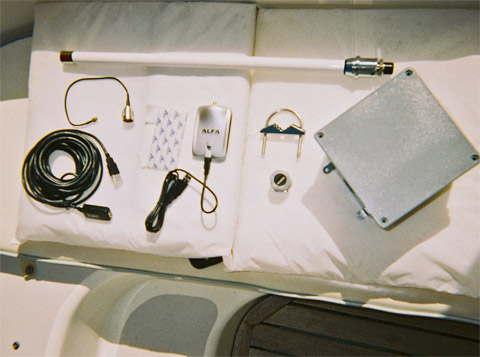
Laid out separately on cockpit cushions…
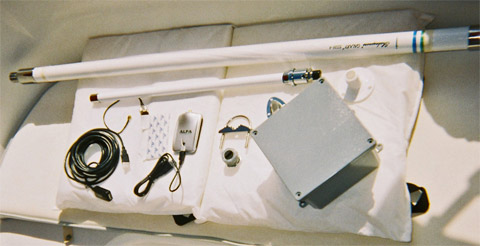
…and with one photo including the 4' Shakespeare antenna extension
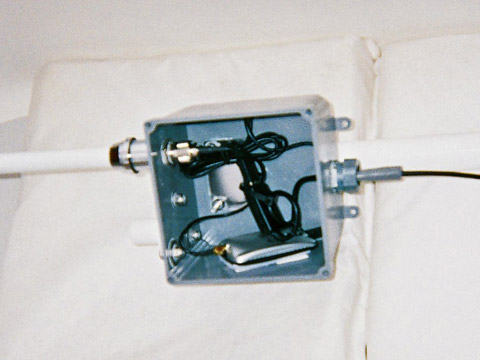
…then assembled / wired together
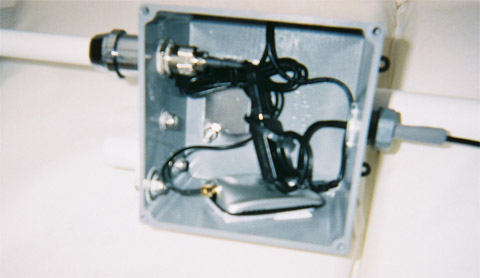
I secured the Alfa unit inside the box, using some heavy-duty Velcro. (note that I drilled holes slightly smaller than needed for the antenna and wiring-feed-thru, and threaded them into the waterproof box, along with a liberal amount of white silicone sealant, and secured by their backing nuts.....) (also note that the ss u-bolt is liberally sealed with silicone and the "u" wrapped with black UV-resistant silicone tape to allow added grip and security....) (You can ignore the round white antenna mount secured to the top of the waterproof box, as this is for future use, along with the empty threaded top of the Shakespeare antenna extension ( for use as a GPS antenna mount and VHF antenna mount, respectively…for a future AIS Class B transponder installation.)…
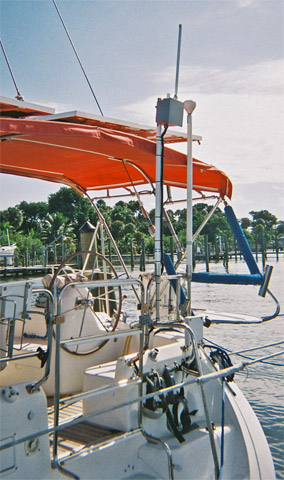
…and then finally mounted and secured. (Note that the waterproof box comes with its own ss screws and rubber gasket, but I also added a layer of silicone sealant to this gasket / flange as well.)
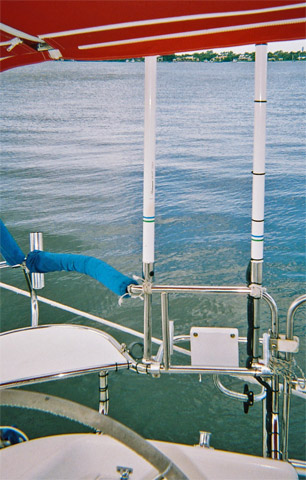
In addition to a 4" piece of heavy-duty cable insulation in the wiring-feed-thru (for added strain relief, etc.), you'll also note I used about 6' of 1/2" UV-rated split-loom tubing to protect the unusually heavy-duty USB cable, and a medium-size SS wiring calm shell screwed to the transom…all keeping the entire set-up / wiring secure and weatherproof.
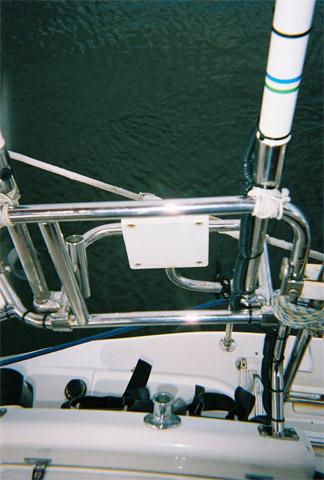
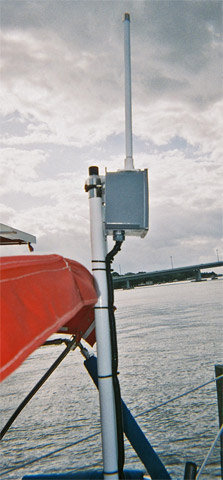
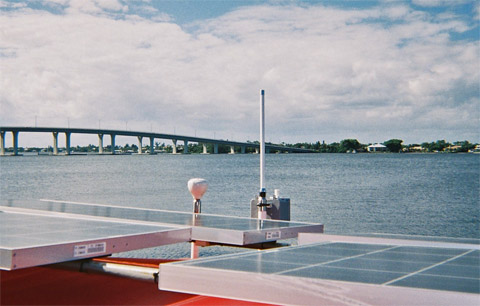
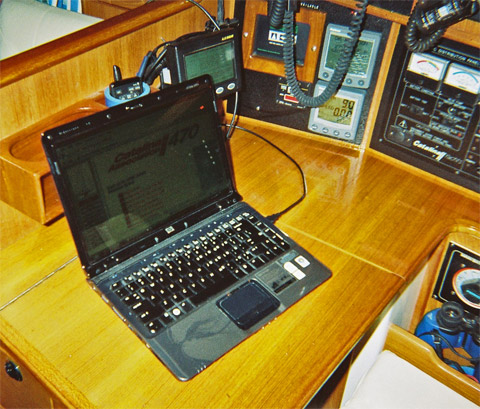
Well, keeping the best for last…how does it work??? Absolutely fantastic!!!! Mounted about 10' above the water, secured to the stern rail, with USB cables run thru lazarette all the way to the main salon, I can sit at the main salon table (or Nav Station) and connect to the internet very easily.
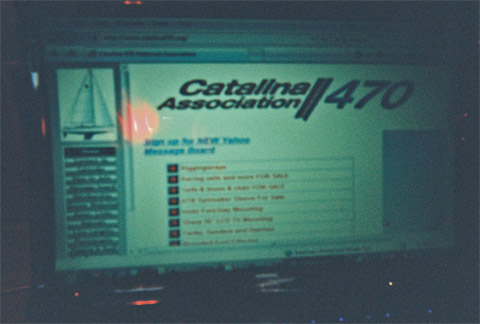
I truly lost count after I had more than 25 Wi-Fi signals…all with 3 - 5 bars of signal strength…and more than 15 of those were "unsecured"…(the 2 or 3 test e-mails I sent were thru different wi-fi sites)… Yes, that's correct, I've consistantly had more than 25 Wi-Fi signals available to me, where I previously had as few as 8 to 16 signals.










